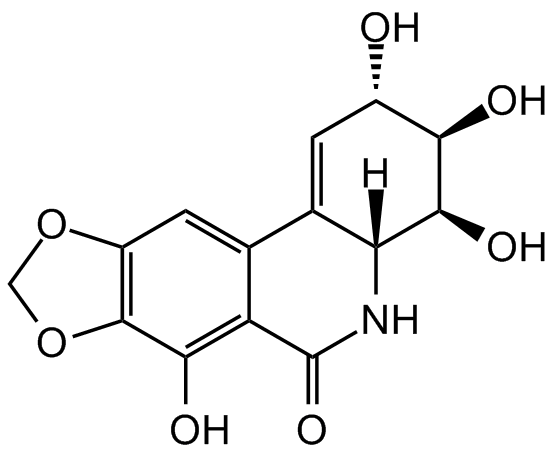Narciclasine
Product Code: AG-CN2-0524
Product Group: Natural Products and Extracts
Supplier: AdipoGen Life Sciences
| Code | Size | Price |
|---|
| AG-CN2-0524-C500 | 500 ug | £75.00 |
Quantity:
| AG-CN2-0524-M001 | 1 mg | £130.00 |
Quantity:
Prices exclude any Taxes / VAT
Overview
Regulatory Status: RUO
Shipping:
Ambient
Storage:
-20°C
Images
Documents
Further Information
Alternate Names/Synonyms:
(+)-Narciclasine; (+)-Lycoricidinol; BRN1087400; NSC266535
Appearance:
Pale grey powder.
CAS:
29477-83-6
EClass:
32160000
Form (Short):
liquid
GHS Symbol:
GHS08
Handling Advice:
Protect from light.
Hazards:
H340
InChi:
InChI=1S/C14H13NO7/c16-6-1-5-4-2-7-13(22-3-21-7)11(18)8(4)14(20)15-9(5)12(19)10(6)17/h1-2,6,9-10,12,16-19H,3H2,(H,15,20)/t6-,9+,10+,12-/m0/s1
InChiKey:
LZAZURSABQIKGB-AEKGRLRDSA-N
Long Description:
Chemical. CAS: 29477-83-6. Formula: C14H13NO7. MW: 307.3. Plant growth modulator/inhibitor.
Anticancer agent. Exhibits antiproliferative and pro-apoptotic effects in carcinoma cells and displays cytotoxic activity against a panel of 60 cancer cell lines. Shown to promote autophagy-induced apoptosis and to slow cell cycle progression.
Inhibits protein synthesis by interacting with the 60S ribosome subunit.
Regulates the Rho/ROCK/LIM kinase/cofilin pathway. Stimulates RhoA activation and induces actin polymerization.
Anti-obesity agent. Attenuates diet-induced obesity (DIO) in mice by promoting oxidative metabolism in skeletal muscle and energy expenditure.
Anti-inflammatory agent suppressing NF-kappaB-dependent gene transcription.
Antiviral agent in vitro.
Antifungal agent.
Shown to inhibit amyloid plaque formation in an Alzheimer's disease model.
MDL:
MFCD01729949
Molecular Formula:
C14H13NO7
Molecular Weight:
307.3
Package Type:
Vial
Precautions:
P308 + P313
Product Description:
Plant growth modulator/inhibitor. Anticancer agent. Exhibits antiproliferative and pro-apoptotic effects in carcinoma cells and displays cytotoxic activity against a panel of 60 cancer cell lines. Shown to promote autophagy-induced apoptosis and to slow cell cycle progression. Inhibits protein synthesis by interacting with the 60S ribosome subunit. Regulates the Rho/ROCK/LIM kinase/cofilin pathway. Stimulates RhoA activation and induces actin polymerization. Anti-obesity agent. Attenuates diet-induced obesity (DIO) in mice by promoting oxidative metabolism in skeletal muscle and energy expenditure. Anti-inflammatory agent suppressing NF-kappaB-dependent gene transcription. Antiviral agent in vitro. Antifungal agent. Shown to inhibit amyloid plaque formation in an Alzheimer's disease model.
Purity:
>98% (HPLC)
Signal word:
Danger
SMILES:
OC1=C(C(N[C@]2([H])C3=C[C@H](O)[C@@H](O)[C@H]2O)=O)C3=CC4=C1OCO4
Solubility Chemicals:
Soluble in DMSO (30mg/ml).
Source / Host:
Isolated from Narcissus sp.
Transportation:
Non-hazardous
UNSPSC Category:
Natural Products/Extracts
UNSPSC Number:
12352200
Use & Stability:
Stable for at least 2 years after receipt when stored at -20°C.
References
Narciclasine: an antimitotic substance from Narcissus bulbs: G. Ceriotti; Nature 213, 595 (1967) | Narciclasine: an antitumour alkaloid which blocks peptide bond formation by eukaryotic ribosomes: L. Carrasco, et al.; FEBS Lett. 52, 236 (1975) | Antiviral (RNA) activity of selected Amaryllidaceae isoquinoline constituents and synthesis of related substances: B. Gabrielsen, et al.; J. Nat. Prod. 55, 1569 (1992) | The Amaryllidaceae isocarbostyril narciclasine induces apoptosis by activation of the death receptor and/or mitochondrial pathways in cancer cells but not in normal fibroblasts: P. Dumont, et al.; Neoplasia 9, 766 (2007) | Chemistry, biology and medicinal potential of Narciclasine and its congeners: A. Kornienko & A. Evidente: Chem. Rev. 108, 1982 (2008) (Review) | Structure-activity relationship analysis of novel derivatives of narciclasine (an Amaryllidaceae isocarbostyril derivative) as potential anticancer agents: L. Ingrassia, et al.; J. Med. Chem. 52, 1100 (2009) | Narciclasine, a plant growth modulator, activates Rho and stress fibers in glioblastoma cells: F. Lefranc, et al.; Mol. Cancer Ther. 8, 1739 (2009) | Narciclasine as well as other Amaryllidaceae isocarbostyrils are promising GTP-ase targeting agents against brain cancers: G. Van Goietsenoven, et al.; Med. Res. Rev. 33, 439 (2013) (Review) | Narciclasine inhibits the responses of Arabidopsis roots to auxin: Y. Hu, et al.; Planta 236, 597 (2012) | Haemanthus coccineus extract and its main bioactive component narciclasine display profound anti-inflammatory activities in vitro and in vivo: S. Fuchs, et al.; J. Cell Mol. Med. 19, 1021 (2015) | Effect of Lycoris chejuensis and Its Active Components on Experimental Models of Alzheimer's Disease: J. Kim, et al.; J. Agric. Food Chem. 63, 6979 (2015) | Narciclasine - an Amaryllidaceae alkaloid with potent antitumor and anti-inflammatory properties: R. Furst, et al.; Planta Med. 82, 1389 (2016) (Review) | Narciclasine attenuates diet-induced obesity by promoting oxidative metabolism in skeletal muscle: S.G. Julien, et al.; PLoS Biol. 15, e1002597 (2017) | Metabolism: Narciclasine boosts energy metabolism: C. Greenhill; Nat. Rev. Endocrinol. 13, 189 (2017) (Review) | Narciclasine induces autophagy-dependent apoptosis in triple-negative breast cancer cells by regulating the AMPK-ULK1 axis: C. Cao, et al.; Cell Prolif. 51, e12518 (2018) | Insight to the antifungal properties of Amaryllidaceae constituents: J.J Nair & J. van Staden; Phytomedicine 73, 152753 (2020) (Review)



